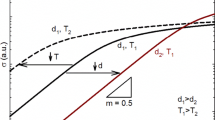Abstract
Optimal structural superplasticity and the deformation of nanostructured materials in the thermally activated region are regarded as being caused by the same physical process. In this analysis, grain/interphase boundary sliding controls the rate of deformation at the level of atomistics. Boundary sliding develops to a mesoscopic level by plane interface formation involving two or more boundaries and at this stage the rate controlling step is boundary migration. In other words, grain/interphase boundary sliding is viewed as a two-scale process. The non-zero, unbalanced shear stresses present at the grain/interphase boundaries ensure that near-random grain rotation is also a non-rate controlling concomitant of this mechanism. Expressions have been derived for the free energy of activation for the atomic scale rate controlling process, the threshold stress that should be crossed for the commencement of mesoscopic boundary sliding, the inverse Hall-Petch effect and the steady state rate equation connecting the strain rate to the independent variables of stress, temperature and grain size. Beyond the point of inflection in the log stress-log strain rate plot, climb controlled multiple dislocation motion within the grains becomes increasingly important and at sufficiently high stresses becomes rate controlling. The predictions have been validated experimentally.
Similar content being viewed by others
References
Ashby M F, Verrall R A 1973 Diffusion-accommodated flow and superplasticity.Acta Metall. 21: 149–163
Astanin V V, Faizova S N, Padmanabhan K A 1996a A model for grain boundary sliding and its relevance to optimal structural superplasticity: Part 2. Evidence for cooperative grain/interphase boundary sliding and plane interface formation.Mater. Sci. Technol. 12: 489–494
Astanin V V, Padmanabhan K A, Bhattacharya S S 1996b A model for grain boundary sliding and its relevance to optimal structural superplasticity: Part 3. The effects of flow localization and specimen thickness on superplasticity in alloy supral 100.Mater. Sci. Techol. 12: 545–550
Betz U, Padmanabhan K A, Hahn H 2001 Superplasic flow in nanocrystalline and sub-microcrystalline yttria-stabilized tetragonal zirconia.J. Mater. Sci. 36: 5811–5821
Eshelby J D 1957 The determination of the elastic field of an ellipsoidal inclusion, and related problems.Proc. R. Soc. London A241: 376–396
Engler O, Padmanabhan K A, Luecke K 2000 Superplastic flow induced texture annihilation.Modelling Simul. Mater. Sci. Eng. 8: 477–490
Enikeev F U, Padmanabhan K A, Bhattacharya S S, 1999 Model for grain boundary sliding and its relevance to optimal structural superplasticity: Part 5. A unique numerical solution.Mater. Sci. Technol. 15: 673–682
Hahn H, Padmanabhan K A 1995a Mechanical response of nanostructured materials.Nanostruct. Mater. 6: 191–200
Hahn H, Padmanabhan K A 1995b Deformation behaviour and possible applications of nanostructured materials.Advanced materials processing. (Proc. Second Pacific Rim Int. Conf. on Advanced Materials Processing, PRICM-2) (Kyongju, Korea: Korean Institute of Metals and Materials) vol. 3, pp 2119–2125
Hahn H, Padmanabhan K A 1997 A model for the deformation of nanocrystalline materials.Philos. Mag. B76: 559–571
Kaibyshev O A 1992Superplasticity in alloys intermetallides and ceramics.(Heidelberg/Berlin: Springer Verlag)
Morris D G 1998 Mechanical behaviour of nanostructured materials.Materials Science Foundation 2 (Aedermannsdorf, Switzerland: Trans. Tech. Publ.) pp 1–86
Nieh T G, Wadsworth J, Sherby O D 1997Superplasticity in metals and ceramics (Cambridge: University Press)
Padmanabhan K A 2000 Deformation of structural superplastics, nanostructured materials and metallic glasses: A unified approach.J. Metastable Nanocryst. Mater. 8: 753–760
Padmanabhan K A 2001 Mechanical properties of nanostructured materials.Mater. Sci. Eng. A304-306: 200–205
Padmanabhan K A, Daniel B S S 2001 Unified theory of deformation for structural superplastics, metallic glasses and nanocrystalline materials.Proc. Int. Conf. Superplasticity in Advanced Materials (ISCAM2000) (Aedermannsdorf, Switzerland: Trans. Tech. Publ.) pp 371–380
Padmanabhan K A, Davies G J 1980Superplasticity (Heidelberg/ Berlin: Springer Verlag)
Padmanabhan K A, Hahn H 1996 Microstructure, mechanical properties and possible applications.Proc. Symp. on Synthesis and Processing of Nanocrystalline Powder (Warrendale: Miner. Met. Mater. Soc.) pp 21–32
Padmanabhan K A, Luecke K 1986 An assessment of the role of texture in structurally superplastic flow.Z.Metallkl. 77: 765–770
Padmanabhan K A, Nitsche R, Hahn H 1995 On the deformation of nanocrystalline metals and ceramics.EUROMAT 95, the 4th Int. Conf. Adv. Mater. and Processes, Symp. G: Special and Functional Materials (Milano: Associazone Italiana Di Metallurgica) pp 289–298
Padmanabhan K A, Schlipf J 1996 A model for grain boundary sliding and its relevance to optimal structural superplasticity: Part 1. Theory.Mater. Sci. Techol. 12: 391–399
Padmanabhan K A, Vasin R A, Enikeev F U 2001 Superplastic flow:Phenomenology and mechanics. (Heidelbeg/Berlin: Springer Verlag)
Perevezentsev V N, Rybin V V, Chuvildeev V N 1992 The theory of structural superplasticity — II. Accumulation of defects on the intergranular and interphase boundaries. Accommodation of the grain boundary sliding. The upper bound of the superplastic strain rate.Acta Metall. 40: 895–905
Valiev R Z, Langdon T G 1993 An investigation of the role of intragranular dislocation strain in the superplastic Pb-62% Sn eutectic alloy.Acta Metall. 41: 949–954
Venkatesh T A, Bhattacharya S S, Padmanabhan K A, Schlipf J 1996 A model for grain boundary sliding and its relevance to optimal structural superplasticity: Part 4. Experimental verification.Mater. Sci. Technol. 12: 635–643
Wolf D 1990a Structure-energy correlation for grain boundaries infcc metals: III. Symmetrical tilt boundaries.Acta Metall. 38: 781–790
Wolf D 1990b Structure-energy correlation for grain boundaries infcc metals: IV Asymmetrical twist (general) boundaries.Acta Metall. 38: 791–798
Author information
Authors and Affiliations
Rights and permissions
About this article
Cite this article
Padmanabhan, K.A. Thermally assisted deformation of structural superplastics and nanostructured materials: A personal perspective. Sadhana 28, 97–113 (2003). https://doi.org/10.1007/BF02717128
Issue Date:
DOI: https://doi.org/10.1007/BF02717128




